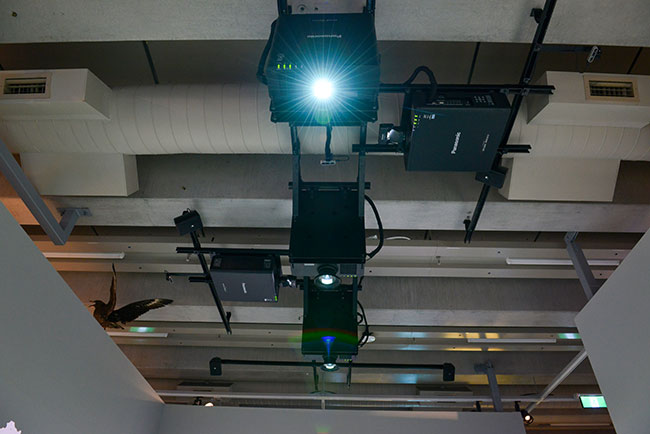The Museum of New Zealand Te Papa Tongarewa (Te Papa for short) is charged with presenting and exploring the heritage of the nation’s cultures and knowledge of the natural environment. The new $12m permanent exhibition: Te Taiao | Nature is the result of a three-year design and build project and is replete with more than three times the audio visual technology of the old Nature zone.
Te Papa’s in-house technology team designed and installed the innovative audiovisual systems that engage the visitors as they travel through the zone.
Audiovisual Manager Andrew Bruce recalled the design process:
“What we tend to do is have some real key pieces; or ‘king hit’ pieces, with a real wow factor,” he noted. There’s plenty of wow factor in the exhibits and artefacts themselves: from recreations of extinct birds to a real (pickled) colossal squid and even an immersive earthquake experience – but with a total of 18 high-powered laser projectors in the zone, projected images are a key element.”
Setting the scene at the entry is a curved projection wall that introduces the animated character Māui who acts as a guide throughout the space, cropping up from time to time within different interactive experiences. The custom resolution image is created using two edge-blended Panasonic laser projectors with geometric distortion correction. A multi-channel surround sound system completes the experience.
Converting the climate

Climate Converter: Immersive Interactive Display
The seven projectors, eight IR cameras and six speakers are mounted on a custom designed and engineered mounting system.
The premier piece from a technology perspective is the fully immersive ‘Climate Converter’ interactive display. As they enter the space, visitors are transported into a virtual space with an animated environment projected onto all four walls and the floor. By working together, visitors can alter the video and audio in their virtual environment using gesture control with the goal of ultimately creating a carbon neutral environment.
Creating the seamless video environment in a limited area was not easy. “Luckily one of our staff members is a projection expert – one of the best in New Zealand,” Andrew revealed. “He worked very closely with Panasonic, who supported us on this exhibition, which gave us access to their engineers regarding lenses, correction technology and everything else.”
The final design for the technology systems included seven HD projectors (with short throw and ultra-short throw lenses).
Andrew recalled. “What was designed on paper and what was actually built were slightly different. While it was designed to be a square room, what was actually built was a parallelogram.”
Standard geometric and lens corrections simply could not cope with the trapezoidal wall shapes. Fortunately, Panasonic’s special Geometric Distortion software had the chops to deal with the twisted shapes and provide a seamless blend.
Projecting a life force
 Just inside the entrance is another of the ‘king hit’ pieces, a four metre high, portrait-format curved screen invites guests to feed their life force or ‘Mauri’ into the exhibition. As visitors work together by placing their hands on the carved wooden touchstone, the on-screen content expands and becomes richer and fuller.
Just inside the entrance is another of the ‘king hit’ pieces, a four metre high, portrait-format curved screen invites guests to feed their life force or ‘Mauri’ into the exhibition. As visitors work together by placing their hands on the carved wooden touchstone, the on-screen content expands and becomes richer and fuller.
The massive 6m-high image is created by a single 10,000-lumen Panasonic projector hidden out of sight above a display cabinet opposite. Altogether, a further seven experiences use projection systems in the Te Taiao | Nature exhibit. All of these projection systems include bespoke and custom designed mounting solutions which include clever access considerations for maintenance of the projectors.

Life Force: This interactive invites guests to work together to feed their life force into the exhibition, by touching the carved centrepiece the content expands and becomes richer and fuller.
Andrew concluded: “There are 18 projectors in the space with a huge amount of curved projection – and that’s the thing that’s very immersive, and impressive,” he reflected. He also loves the reliability of laser powered projectors – he wouldn’t use anything else these days.
Andrew is very happy with the visitor statistics.
FULL ARTICLE“We’re getting a tremendous conversion rate. That means that currently, about two-thirds of people that come to the museum will go to this exhibition. And when you have about one point five million visitors a year to Te Papa, you’re looking at one million visitors through the exhibition in the first year alone!”
To find out more about our commercial projection and display technologies visit Panasonic Visual System Solutions, or contact our sales support.
Contact us
Contact us for more information on Panasonic Business products:.




